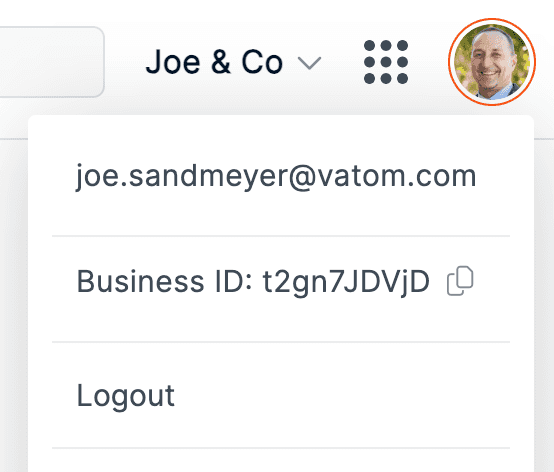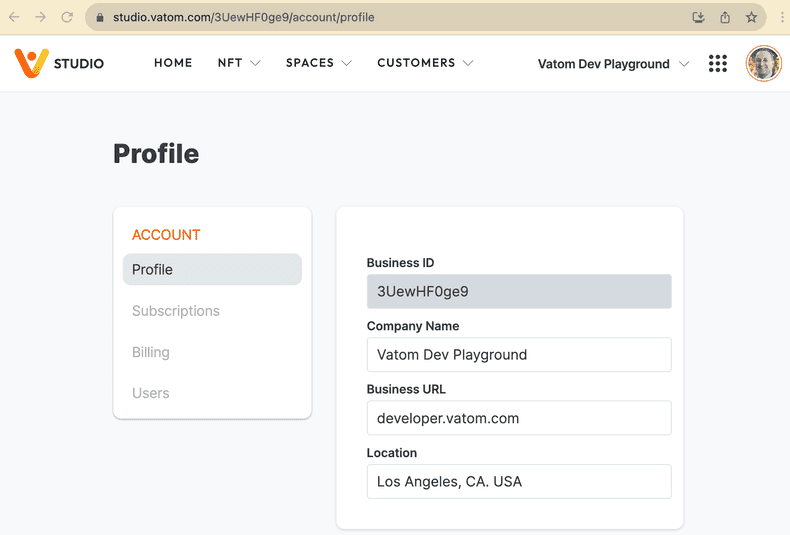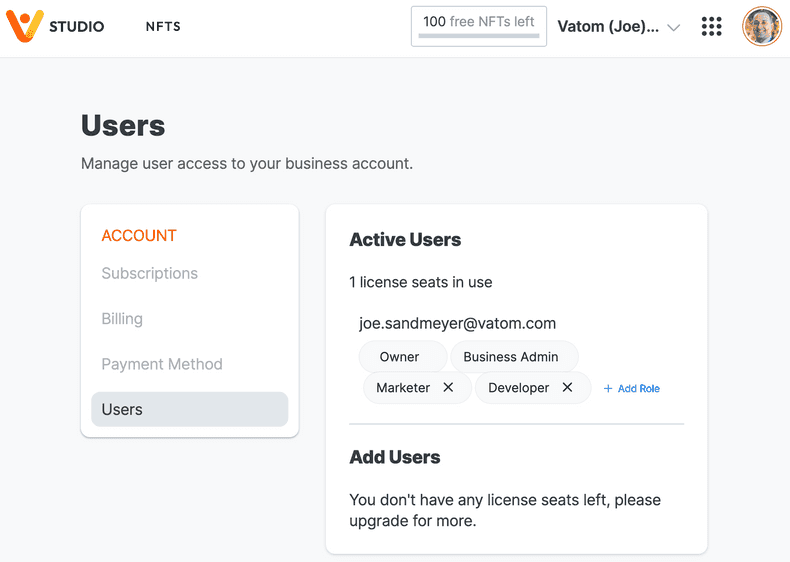Add API Credentials
Request by sending an email to developer@vatom.com
Glossary
Account Dropdowns
Three dropdown menus appear in the upper right corner when using Vatom tools that manage features related to Vatom Business Accounts.

Business Dropdown
If you are a member of more than one Business ID, the business dropdown identified in the image above lets you select which of your business IDs you would like to work on.
Bento Dropdown
The bento dropdown is at the center of the Account Dropdowns with an icon resembling a bento box. It lets you choose which set of tools you or Vatom App would like to use with the business assets currently selected by the Business Dropdown.
User Dropdown
The user dropdown is represented by a user identity icon and is the rightmost of the Account Dropdowns. It lets you access settings relevant to the current selections of the Business Dropdown and Bento Dropdown.
Business ID
Vatom Spaces, NFT designs, campaigns, plugins, and other related assets hosted by Vatom are each assigned one Business ID as their owner. A Business ID represents a business account to which any number of users can be granted membership, with varying privilege levels. Users can also be granted membership to multiple Business IDs. Each Vatom user account created by a developer or content creator includes a Business ID that could potentially be shared with other users.
Each Business ID is uniquely identified by an alpha-numeric code. Once a Business ID is created, this unique code remains fixed. A human readable name can be assigned to a Business ID and edited at any time by a member with admin privileges. Unlike the business ID, this name is not guaranteed to uniquely identify the account.
Viewing Business IDs For Your Accounts
When logged into the developer.vatom.com portal, you can view your personal Business ID by clicking on your User Dropdown. If you are a member of multiple Business IDs, first use the Business Dropdown to select which business ID you would like to inspect.

Editing Business Profiles in Studio
You can use the same dropdowns in studio.vatom.com to not only view your business IDs but also edit the profiles associated with them.

Public Information on Any Business ID
A portion of every business ID is public information. You can use the Get Business Info REST API on any valid business ID to access this public information.
Since this is public information, there is an alternate REST endpoint that does not require authentication allowing it to be more conveniently executed from a terminal prompt such as the following. Just substitute an actual business ID for the "abcBizIDxyz" placeholder value below.
% curl -X GET 'https://businesses.vatom.com/abcBizIDxyz' | npx jsonOne specific value to note in the output is the "ownerId" property. This value refers to a specific user whereas any number of users may be associated with a business ID.
Business Member Roles
A business member is someone who has been invited to participate in creating, configuring, and tracking the experience that end users have with content built and delivered with Vatom tools. Business members are assigned one or more of the following roles based on their responsibilities and the access privileges that they need.
Owner
Ultimately responsible for the account. Can grant and revoke roles for any member.
Business Admin
Administer business members and settings.
Billing Admin
Manage billing and licensing.
Marketer
Create digital objects and campaigns.
Developer
Create behaviors, blueprints, and designs.
Customer Support
Support (restricted) role.
Support Admin
Support role.
Viewing & Modifying Roles
Members with an Owner or Business Admin role in a given Business ID may view and modify the roles assigned to any member, including themselves. To use this privilege, they can use the following steps and the screenshot below:
- Open studio.vatom.com in a browser.
- Use the Business Dropdown to select the appropriate business ID.
- Use the User Dropdown to choose
Account. - Click
Usersin the left side panel. - View the list of
Active Usersto see what members exist and what roles have have been assigned to them. - Click
+ Add Roleto assign an additional role to a member. - Click the
Xthat follows a role name to remove a role from a member. - To invite a new member, insert their email under
Add Usersand click theInvitebutton. If your license seats have been consumed, you will see a message about the need to upgrade your account before more members can be added.

Download User Roles As JSON
If you are supporting a large organization as both a Business Admin and Developer, you may find it useful to download the entire list of members and their roles in JSON format. You can execute a REST API endpoint directly from the Get Business Users page to collect this information. If you have not yet explored the REST API, take a quick look at Use The Lab To Experiment.
Changelog
A Changelog is a list of notable changes we track when an update to a Vatom product is released. All of our product changelogs are visible in one place at feedback.vatom.com/changelog. You can narrow down the products you are interested in by selecting checkboxes in the left side panel.
Developer Keys
Developer Keys serve to unlock a developer's configuration settings for a Vatom feature that has been registered with Vatom servers. These keys carry at least an identity component and and some means of authentication for that identity. In addition, they may offer more granular authorization for specific scopes. Developer Keys apply to the following Vatom features:
- Identity SDK
- REST APIs
Developer Keys for Identity SDK
When initializing the Identity SDK in your app, you will need to specify your own developer key for this feature. Authentication of your key is managed by whitelisting the URLs of the web app that use this key.
Developer Keys for REST APIs
Most Vatom REST APIs require some kind of authorization. A developer key is one type of authorization, but not the only type that can be used. When a Vatom REST API accepts a developer key for authorization, it expects a Client ID paired with a secret value. It also expects that this request is issued from a computer that the developer securely controls so that the secret value remains hidden from malicious actors. This developer key for REST APIs consists of an OAuth2 Client Credential Grant Type.
Note that some REST APIs alternatively accept an access token generated from an OAuth2 Authorization Code Grant Type corresponding to a specific end user. This access token provides an extra level of security that allows it to be used in code distributed to the public as part of a mobile or web app.
Development Mode Enabled Banner
When adding plugins to Spaces via sideloading,
a Development Mode Enabled banner will appear at the top of the space.
This banner indicates that an unpublished plugin is in use.
When the banner is dismissed by any user, it will disappear for all users
present in the space for about five minutes before appearing again.

For more information, see notes under Plugins In Spaces regarding published and unpublished plugins.
Gathering Size
( a.k.a. size property in certain JSON payloads)
Gathering Size refers to the number of simultaneous users that will be allowed to enter a space at one time. Potential values include:
| Description | Capacity | string value of size property in JSON |
|---|---|---|
| Small | up to 25 | small |
| Medium | up to 50 | medium |
| Large | up to 100 | large |
| X-Large | up to 150 | xlarge |
| XX-Large | over 150 | xxlarge |
Grant Type
Grant Type is an OAuth2 term referring to the type of authorization credential held by a software application as evidence of specific access privileges it should be allowed. Vatom supports the following two types of OAuth2 Grant Types:
| Description | string value when used in a request body parameter |
|---|---|
| Authorization Code | authorization_code |
| Client Credentials | client_credentials |
| Token Exchange | urn:ietf:params:oauth:grant-type:token-exchange |
Authorization Code Grant Type
Applications that provide a user interface and authenticate the identity of the user
use a credential based on the authorization code grant type.
This approach includes a means of protecting the credential against misuse even when
it is stored by an application residing on the user's own hardware.
Client Credentials Grant Type
If an application resides on a server not exposed to the public and can be trusted
with a secret, it can make use of the more streamlined client credentials approach
based on an application identifier and secret key instead of an authorization code.
Token Exchange Grant Type
If an application has an access token for a user generated by an identity system that is trusted and integrated with Vatom, it can make use of a Token Exchange to obtain a valid Vatom access token by exchanging that token.
Plugins
Plugins, in general, refer to optional modules added to a core system. In the Vatom context, this usually refers to software extensions added to Spaces as described below.
Plugins In Spaces
Additional features can be added to Spaces via plugins. You can install plugins into your Space by selecting the Plugins button from the top menu of the Spaces editor. You can visit the Plugin Marketplace directly to view available plugins.
You can also create your own plugins for Spaces, which allow you to create extra buttons, clickable in-world objects, or anything else you can think of!
Published Plugins In Spaces
Some of the plugins available from the Plugin Marketplace have been created by Vatom but most of them have been independently developed and published there by third party developers.
Unpublished Plugins In Spaces
When developing your own plugins, you can add them to a space by sideloading. This provides a more convenient way to test and update the plugin during the development process without going through the process of publishing the plugin. See Sideloading Plugins Into Spaces for more information.
Sideloading
Sideloading, in general, refers to copying software to a device or environment via a secondary means rather than the primary method. In the Vatom context, this usually refers to a process for installing unpublished plugins in Spaces as described below.
Sideloading Plugins Into Spaces
When a developer is building a new plugin for Spaces, they will sideload the plugin for testing prior to the point where they are ready to publish it in the Plugin Marketplace. Note that when a space contains a sideloaded plugin, a "Development Mode Enabled" banner will appear at the top of the space.
Spaces
Vatom Spaces are 3D virtual worlds that can be visited with a browser. Like other websites, each Vatom Space is hosted at a web address. The metaverse can be as accessible as a web page with Vatom Spaces. See vatom.com/platform/virtual-spaces/ for an introduction.
Spaces Editor
Vatom Spaces include built-in editing features. Upon entering a space, these editing features are presented only to users who are registered with privileges for editing that space.
User Access Level
( a.k.a. accessLevel property in certain JSON payloads)
User Access Level refers to access restrictions placed on Vatom Spaces. Potential values include:
| Description | string value of accessLevel property in JSON |
|---|---|
| Allow Everyone | anonymous |
| Request Basic Profile | guest |
| Require Login | user |
User ID vs. User Name
Note that the Vatom userId and username properties are distinct from each other
and they both have the ability to identify a user.
User ID
The userId property is created once when a user is added to the system.
It is created as unique and and cannot be changed.
Its value is a nearly random string of alphanumeric characters.
User Name
The username is an optional property that is not defined for all users.
Since multiple users may not have this property defined, it cannot always be relied upon
to distinguish one user from another.
The value of this property can be changed at any time for a given user.
When defined, it usually consists of a nickname chosen by the user themself.